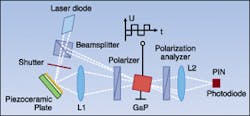Fast NIR adaptive interferometer uses GaP

Measurement of small out-of-plane vibrations of optically rough surfaces is useful in nondestructive testing and condition monitoring. Whereas utilization of polarization self-modulation techniques with semiconductor crystals at red wavelengths has been shown to result in a fast response time of 5 ms, practical implementation is costly. Now physicists at the University of Joensuu (Joensuu, Finland) have reportedly achieved the fastest known response time of 1.9 ms in adaptive near-infrared (NIR) interferometers, which allows use of low-cost NIR laser diodes.
Oleg Kobozev and colleagues reported observations of the space-charge-field formation obtained in photorefractive gallium phosphide (GaP) crystal at 807 nm. The interferometer consisted of a semi-insulating GaP crystal in the shape of a parallelepiped. The beam from the diode laser with maximum output power of 100 mW was split and reflected off the rough surface of a piezoceramic plate on one side and sent through the crystal on the other, such that they interfered inside the GaP sample (see Fig. 1). A sinusoidal voltage modulated the phase difference between the piezoceramic plate and the reference beam, while a polarizer at the entrance face of the crystal caused both the scattered light and reference beam to attain the same linear polarization. An alternating bipolar electric field was applied to the crystal to increase the space-charge field created by the interference pattern. A PIN photodiode then collected the transmitted scattered light.
At first approximation, the response time approximates that of the Maxwell relaxation time, τM, which is inversely proportional to the photoconductivity. Increasing light intensity, I, corresponds to an increase in photoconductivity and a linear decrease in response time, τ, as τ = a/I, where a is a coefficient equal to 5.1 ms-W-cm-2 (see Fig. 2). The researchers claim this linear dependence is evidence of the linearity of the lux-ampere characteristic curve of the photoconductive GaP crystal in the near infrared.The response time of 1.9 ms at a light intensity of 2.4 W-cm-2 is the fastest response time among known adaptive interferometers in the near infrared. The fast response is due largely to the high extrinsic photoconductivity of the GaP crystal, which is caused by relatively high light intensity. That fact, along with commercial availability of NIR laser diodes, makes the GaP crystal an excellent prospective material for adaptive detection of small out-of-plane vibrations. The team reported that application of a more powerful laser with an improved Gaussian-beam profile would further decrease the response time of the space-charge-field formation.
About the Author
Valerie Coffey-Rosich
Contributing Editor
Valerie Coffey-Rosich is a freelance science and technology writer and editor and a contributing editor for Laser Focus World; she previously served as an Associate Technical Editor (2000-2003) and a Senior Technical Editor (2007-2008) for Laser Focus World.
Valerie holds a BS in physics from the University of Nevada, Reno, and an MA in astronomy from Boston University. She specializes in editing and writing about optics, photonics, astronomy, and physics in academic, reference, and business-to-business publications. In addition to Laser Focus World, her work has appeared online and in print for clients such as the American Institute of Physics, American Heritage Dictionary, BioPhotonics, Encyclopedia Britannica, EuroPhotonics, the Optical Society of America, Photonics Focus, Photonics Spectra, Sky & Telescope, and many others. She is based in Palm Springs, California.

